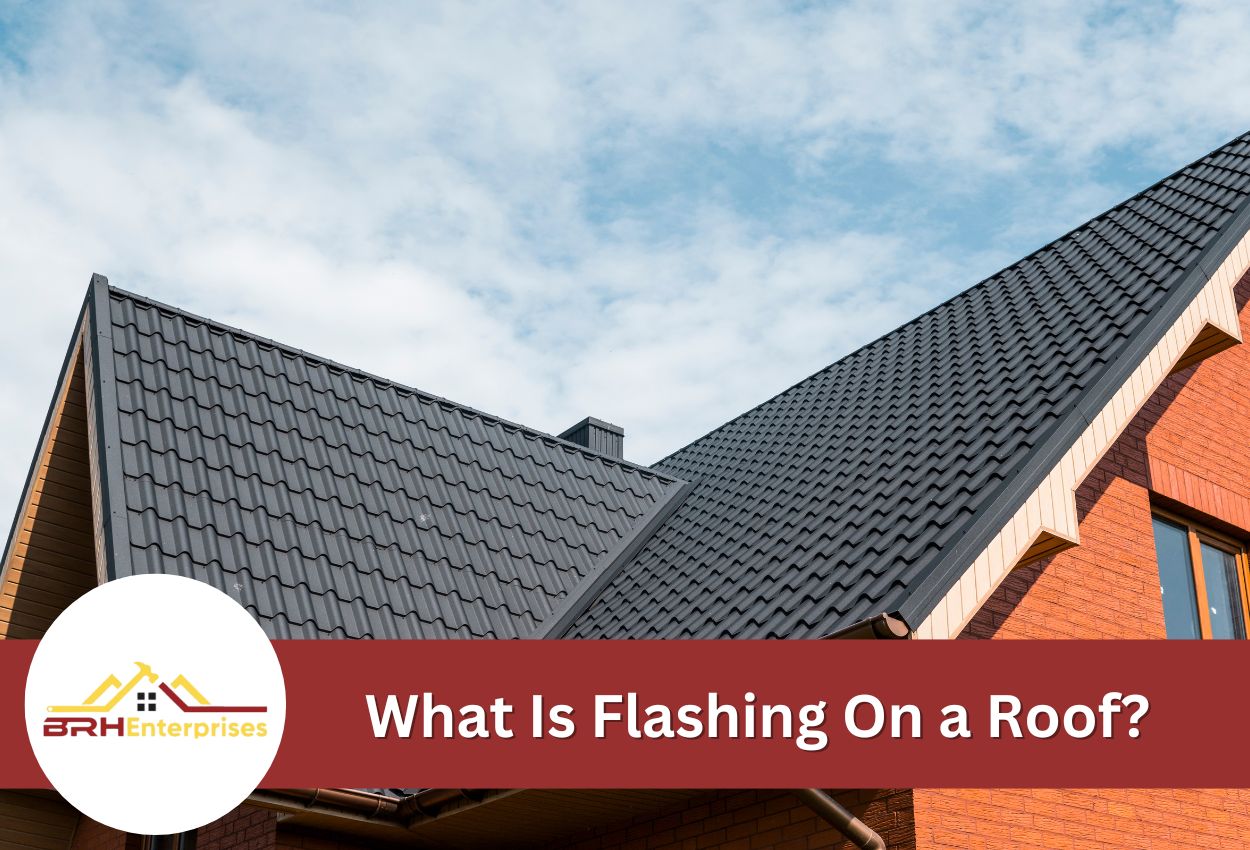Each part of your roofing system has an essential role in its overall performance. While you may not notice it, roof flashing is one of the most important parts of your roofing system.
Our team at BRH Enterprises LLC is your local roofers serving Mayville, WI, and the surrounding areas.
In today’s article, we will go over everything you need to know about roof flashing in 2025. If you are looking for a free, no-obligation conversation with our professionals about your roof, reach out to us today at (920) 249-4228.
What Is Roof Flashing, And Why Is It Important?

Roof flashing is a thin metal material that is installed strategically to direct water away from vulnerable areas where your roof meets vertical surfaces or where there are joints and seams. For example, flashing creates a barrier in areas where shingles butt up against something, such as walls, chimneys, dormers, skylights, or valleys. Think of it as a waterproof seal that prevents moisture from seeping into vulnerable spots.
The importance of roof flashing cannot be overstated. Without properly installed flashing, water would easily penetrate your roof at these junctions, which can result in major water damage, mold growth, rotting wood, and costly structural repairs. Even the highest quality shingles cannot prevent leaks at these intersections without flashing.
This thin metal component effectively channels water down and away from these areas, ensuring moisture follows the proper drainage path rather than finding its way into your home. Many roofing professionals consider flashing to be one of the most important components of a well-built roof.
What Are The Different Types Of Roof Flashing?
Now that you know the general purpose of roof flashing, here we will discuss some of the common types of roof flashing.
#1 Step Flashing
Step flashing is primarily used where a roof plane meets a vertical wall, such as the side of a chimney or where the roof meets a dormer wall. It consists of rectangular pieces of metal bent at a 90-degree angle that are installed in layers with the shingles to create a waterproof barrier.
What makes step flashing unique is how it’s installed, in steps, which gives it its name. Your roofer will place a shingle, then a piece of flashing, then another shingle, then another piece of flashing, and so on until the entire wall junction is protected.
Each piece of step flashing is partially covered by the shingle above it, creating a cascade effect that directs water down and away from the wall.
This methodical, step-by-step installation ensures that water flowing down the roof surface is always directed to the outer surface of the shingles rather than behind them, where it could cause damage. Because step flashing is layered with the shingles, it remains mostly hidden from view once installation is complete.
#2 Counter Flashing
Counter flashing works together with base flashing or step flashing to provide extra protection in areas like chimneys and walls. While step flashing is placed under the shingles and against the wall, counter flashing is installed directly on the vertical surface and extends down over the top edge of the base or step flashing.
For chimneys specifically, counter flashing is generally embedded into the mortar joints of the brick or masonry. A roofing professional will cut a groove into the mortar joint, insert the bent edge of the counter flashing into this groove, and then seal it in place. The bottom portion of the counter flashing overlaps the top of the base flashing, creating a two-part system that’s extremely effective at preventing water intrusion.
What makes counter flashing different from other types is that it’s usually visible after installation. The metal you can see running along the side of your chimney or wall is typically counter flashing. Its two-part design also allows for the natural expansion and contraction of building materials during temperature changes without compromising water protection.
#3 Apron Flashing
Apron flashing, sometimes called base flashing, is a simple L-shaped piece of metal that creates a waterproof barrier at the base of vertical structures on your roof. It’s commonly used at the bottom edge of chimneys, walls, and dormers where they meet the roof surface.
This type of flashing resembles an apron (hence the name) as it extends under the shingles on the roof surface and up against the vertical structure.
Apron flashing pieces can be quite long, sometimes over 10 feet long, to fit the entire base of a wall or large penetration. For dormers and windows that protrude from your roof, apron flashing is essential to prevent water from getting behind the siding and into your home.
The simplicity of apron flashing makes it highly effective. Its L-shape creates a smooth transition that allows water to flow naturally down the roof without finding its way into the joint between the roof and vertical surface.
#4 Valley Flashing
Valley flashing is installed where two roof slopes meet to form a valley, one of the areas on your roof that collects the most water during rainfall. These V-shaped channels require special protection because they handle a high volume of water runoff from both adjoining roof surfaces.
There are two main approaches to valley construction: closed valleys (where shingles from both roof planes overlap in the valley) and open valleys (where metal flashing is visible). For premium roofing materials like cedar shakes, slate, or certain luxury shingles that can’t bend easily to create a closed valley, open valley flashing is necessary.
In an open valley system, a wide piece of metal flashing spans the entire length of the valley. This metal is typically shaped like a “V” to channel water down the center of the valley rather than allowing it to pool or seep under the roofing material. The edges of the valley flashing extend under the shingles on both sides, creating a durable, waterproof channel.
Valley flashing is especially important because valleys typically collect and direct more water than any other part of the roof. Properly installed valley flashing ensures this water flow is safely channeled off your roof.
#5 Drip Edge Flashing
Drip edge flashing is installed along the edges of your roof at the eaves and rakes. This L-shaped piece of metal extends slightly beyond the edge of the roof and bends downward to direct water away from the fascia and into the gutters.
Without drip edge flashing, water could curl around the edge of your roof and damage the fascia board, soffit, and even the interior of your home. The drip edge creates a clean termination point for your shingles while providing protection for the vulnerable edges of your roof.
In many regions, building codes now require drip edge flashing because it’s necessary to prevent water damage. It also helps protect the edge of the roof deck from rot and provides a finished look to your roof’s perimeter.
#6 Vent Pipe Flashing
Also known as pipe boots or boot flashing, vent pipe flashing creates a protective watertight seal around plumbing vents and other pipes that penetrate your roof surface. These are typically cylindrical pieces of flashing with a flexible rubber or metal collar that fits snugly around the pipe.
The base of the pipe boot has a wide flange that integrates with your roofing materials. Shingles are installed over the top portion of the flange while the lower portion covers the shingles.
The height of the boot forces water to run around the vent rather than pooling around it, preventing one of the most common sources of roof leaks. Over time, the rubber or neoprene collar can deteriorate from UV exposure, so these components should be inspected regularly.
#7 Kickout Flashing
Kickout flashing, sometimes called diverter flashing, is a small but crucial piece installed where the edge of your roof meets a sidewall. Its purpose is to divert water into the gutter system rather than allowing it to run down the wall.
Without kickout flashing, water can seep behind your siding, leading to rot, mold, and serious structural damage. This special piece of flashing is shaped to “kick out” water away from the wall and toward the gutter, making it an essential component at roof-to-wall transitions.
Unfortunately, kickout flashing is sometimes overlooked during installation, but experienced roofing professionals understand its importance in preventing water intrusion at these critical junctions.
How To Install Roof Flashing?
Proper installation of roof flashing is critical to keep your roof watertight for years to come. While it is recommended to hire professional roofers for this task, understanding the basic process can help you make better decisions about your roof.
#1 Preparation
Your roofing contractor will start by cleaning the area where the flashing will be installed, removing any old flashing, debris, and loose roofing materials. They’ll also inspect for any signs of damage or rot that should be addressed before the new flashing goes in.
#2 Measurement And Cutting
Next comes precise measurement and cutting. Each piece of flashing needs to be carefully measured and cut to fit the specific area it will protect. Step flashing generally means creating rectangular pieces that are wider than the exposure of your shingles. Valley flashing might require much larger pieces, while chimney flashing demands multiple custom-cut components.
#3 Ensure A Perfect Fit
For a proper fit, roofers will often place the cut flashing in position before securing it. This allows them to make any necessary adjustments to ensure a perfect fit. Some types of flashing, like step flashing, may need to be bent to the proper angle to fit snugly against both the roof surface and the vertical wall.
#4 Secure The Flashing
When it comes to securing the flashing, your roofer will use fasteners like roofing nails or screws. However, they must be strategic about placement. For example, with step flashing, nails are typically placed high on the vertical portion so they’ll be covered by siding or counter flashing. On the roof plane side, nails are positioned high enough to be covered by the next course of shingles.
#5 Check For Proper Overlapping
Proper overlapping is very important for effective water management. Each piece of step flashing must overlap the one below it by at least 3 inches. For valley flashing, the overlap should be even more generous (at least 6 inches at any joints along the valley).
#6 Apply Appropriate Sealants
Finally, your roofer will apply sealants to create a watertight seal. Roofing cement is commonly used to seal nail heads and any potential gaps. However, experienced roofers know that relying solely on sealant is never a good practice. Proper installation techniques and overlapping patterns are the primary defense against leaks.
For specific applications like chimney flashing, the process becomes more complex. It generally involves installing base flashing around the bottom of the chimney, cutting grooves into the mortar to insert counter flashing, and creating a custom cricket or saddle on the upslope side to divert water around the chimney. Installing flashing on your roof requires both skill and experience for proper execution and performance.
Remember that flashing installation must be coordinated with the installation of your roofing materials. For instance, step flashing is installed simultaneously with your shingles, alternating between the two as the roof is built up from bottom to top. This integration between flashing and roofing materials is essential for creating a completely watertight system.
What Are the Consequences Of Improperly Installed Roof Flashing?
When roof flashing isn’t installed correctly, water can sneak under your roof and into your home. This starts small but gets worse over time. You may see water stains on ceilings, peeling paint, or bubbling wallpaper (generally far from where the water is coming in).
Damp spots can cause mold growth, which can make your family sick and require expensive remediation. Water can also rot wood, rust metal pieces, and even damage your foundation. Wet insulation doesn’t work well, so your heating and cooling bills may go up. Plus, incorrectly installed flashing can void your roof warranty, leaving you to pay for all repairs yourself.
You May Also Like: Understanding The Key Components Of A Roof
Choose BRH Enterprises LLC for Professional Roofing Services in Wisconsin
BRH Enterprises LLC is your local roofing company serving Mayville, Wisconsin, and nearby areas like Watertown and Fox Lake. Our team has the right skills, experience, and knowledge to take on any roofing project, from inspections to complete replacements.
Whether flashing or other roofing materials, we will make sure that even the smallest part of your roofing system is installed correctly so your roof performs well for years to come.
We use only high-quality flashing materials that will stand up to Wisconsin’s challenging weather conditions, from heavy snow and ice to summer thunderstorms.
Every project receives our full attention to detail, so your home remains protected through every season.
To schedule a free roof inspection or to talk with our professionals, call us today at (920) 249-4228.



